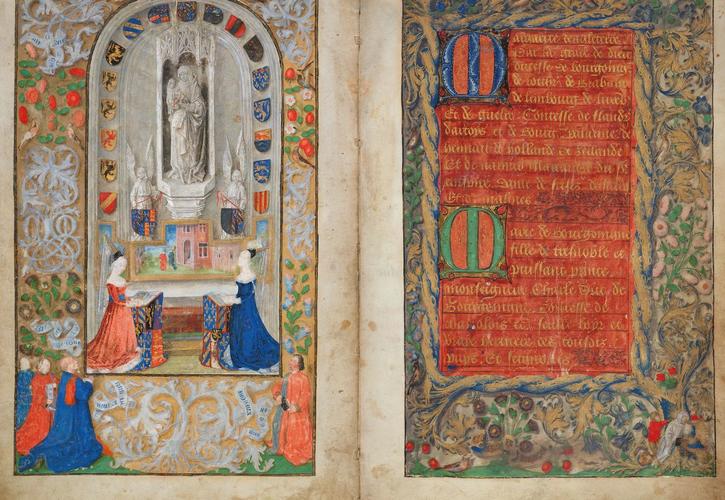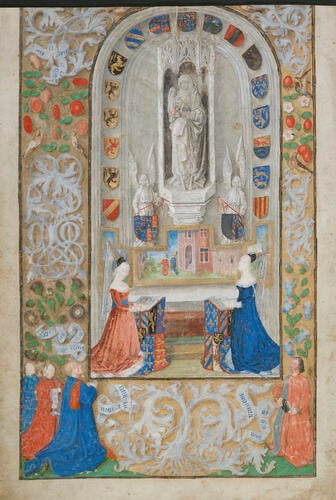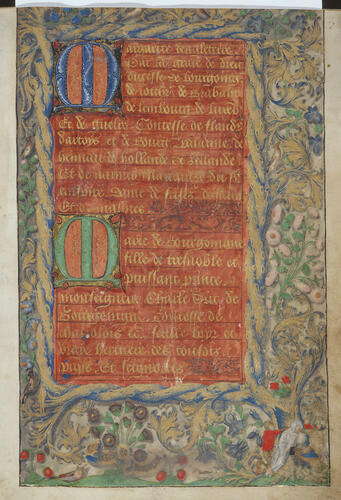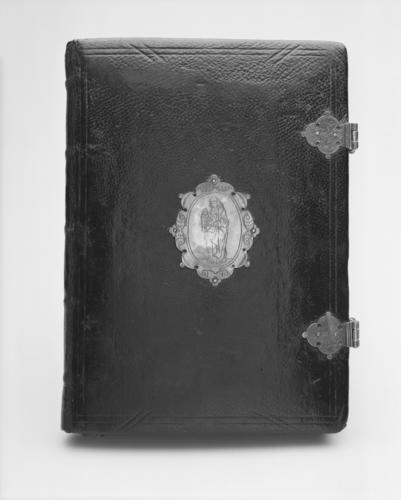-
1 of 253523 objects
Register of the Guild of St Anne c.1476
Manuscript on vellum, 82 fols; gold and bodycolour | 33.0 x 5.5 cm (book in box) | RCIN 1047371

Circle of Vienna Master of Mary of Burgundy (active c. 1469-c. 1483)
Register of the Guild of St Anne at Ghent c.1476

Circle of Vienna Master of Mary of Burgundy (active c. 1469-c. 1483)
Register of the Guild of St Anne at Ghent c.1476

Circle of Vienna Master of Mary of Burgundy (active c. 1469-c. 1483)
Register of the Guild of St Anne at Ghent c.1476




-
82 folios. Black goatskin binding, with silver cartouches on both covers, and silver clasps
Margaret of York (1446-1503) was the third wife of Charles the Bold (1433-77), ruler of Burgundy, and sister to Edward IV (1442-83) and Richard III (1452-85) of England. Her marriage in July 1468 cemented mutual ties of diplomatic friendship and trade agreements between England and the Burgundian territories, which included Flanders. She would have been expected to provide Charles with a male heir; his only surviving child from his previous marriages was Mary of Burgundy (1457-82), who in August 1477 married Maximilian of Austria, later Emperor Maximilian I.
The dynastic importance of bearing a son explains Margaret’s devotion to St Anne, patron saint of pregnant women and those who wished to become pregnant.The Guild of St Anne in Ghent, founded in the mid-fifteenth century, offered charitable assistance to encourage remarriage and the subsequent bearing of children, particularly important after the Revolt of Ghent (1449-53) against their Burgundian overlord, Philip the Good (1396-1467), which brought great loss of life. The guild instituted new statutes in 1470, and in 1473 welcomed Margaret as a member, followed in 1476 by her stepdaughter Mary.
The guild commissioned and paid for this Register, which lists guild members from the 1470s up to the late eighteenth century, with its handsome illuminated opening for its patroness.On the left-hand page of the opening shown here the four officials of the guild kneel at the foot of the page, while the central panel shows the two royal ladies, Margaret [left] and Mary [right], each kneeling at a prie-dieu adorned with their arms, before a statue of St Anne. Their arms are repeated on escutcheons held by two angels either side of the saint. The dexter (the viewer’s left hand) side of Mary’s arms has been left blank in recognition of her expected forthcoming marriage to Maximilian. Beneath the saint a painted panel shows the Angel Gabriel announcing to St Anne’s husband Joachim that his wife would bear a child (the Virgin Mary) who would become mother to the Messiah. The page border is decorated in the new Flemish naturalistic style, with coils of acanthus interspersed with violets, strawberries and daisies (their name in French, marguerite, being a play on Margaret’s name), and white wreaths bearing Margaret’s motto Bien en aviengne (‘May good come of it’). The initials ‘C’ and ‘M’ are intertwined on the outer border, while the arms of the territories of Burgundy are displayed round the arch surrounding the figure of St Anne. The facing page border repeats many of these motifs, with the uncommon addition of a white-robed hermit and a monkey in a red coat in the bottom righthand corner. A hermit was also included in the border of the Voustre Demeure Hours by the Vienna Master of Mary of Burgundy. The text panel outlines the ranks and titles of the two ladies on a red background, in imitation of imperial purple, which would emphasise particularly the description of Mary of Burgundy as her father’s true and only heir.
The manuscript was probably begun in 1476, after Mary of Burgundy joined the guild, but its illumination was probably not finished until the following year, since the manuscript includes an inscription (fol.6r) alluding to the death of Charles the Bold at the battle of Nancy in January 1477.The illumination was produced by an artist of the circle of the Vienna Master of Mary of Burgundy (active c.1469-c.1483).
The manuscript industry in Flanders, particularly in Bruges and Ghent, had been producing luxury devotional manuscripts since the early thirteenth century, many for export to England, but the artistic patronage of Philip the Good in the mid-fifteenth century had a transforming effect on the market by encouraging painters to work on manuscript illumination. Flemish painting style thus began to influence Flemish manuscript painting, as exemplified by the Vienna Master. His work shows the influence particularly of Hugo van der Goes (c.1440-1482) and Joos van Ghent (active c.1460-80) in its pictorial quality and emotional impact. He was also among the first artists to produce the new naturalistic borders.
Catalogue entry adapted from The Northern Renaissance. Dürer to Holbein, London 2011.Provenance
Acquired by 1894
-
Creator(s)
Circle of (illuminator)(corporate author) -
Medium and techniques
Manuscript on vellum, 82 fols; gold and bodycolour
Measurements
33.0 x 5.5 cm (book in box)
Category
Alternative title(s)
Register of the Guild of St Anne at Ghent.